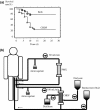History and current status of polymyxin B-immobilized fiber column for treatment of severe sepsis and septic shock
- PMID: 29863114
- PMCID: PMC5881300
- DOI: 10.1002/ags3.12015
History and current status of polymyxin B-immobilized fiber column for treatment of severe sepsis and septic shock
Abstract
Toraymyxin® (Toray Medical Co., Ltd, Tokyo, Japan) has been developed as a direct hemoperfusion column that contains polymyxin B-immobilized fiber to bind endotoxins in patients' blood. Toraymyxin was approved by the Japanese National Health Insurance system for the treatment of endotoxemia and septic shock in 1994. Since then, PMX (defined as direct hemoperfusion with Toraymyxin) has been safely used in more than 100 000 cases in emergency and intensive care units in Japan. Toraymyxin is currently available for use in clinical settings in 12 countries outside of Japan. We reviewed and analyzed the development, clinical use, and efficacy of Toraymyxin, and assessed the current status of Toraymyxin use for the treatment of severe sepsis and septic shock. Our review shows that PMX appeared to be effective in improving hemodynamics and respiratory function in septic shock requiring emergency abdominal surgery. Recent large-scale ranomized controlled trialscould not demonstrate whether prognosis is improved by PMX. However, the latest meta-analysis revealed that PMX significantly decreased mortality in patients with severe sepsis and septic shock. Combination of PMX with continuous hemodiafiltration and longer duration of PMX might be an effective strategy to improve survival in such patients.
Keywords: Toraymyxin; blood purification; direct hemoperfusion with Toraymyxin (PMX); endotoxin; sepsis.
Figures






Similar articles
-
Endotoxin adsorption: Direct hemoperfusion with the polymyxin B-immobilized fiber column (PMX).Transfus Apher Sci. 2017 Oct;56(5):682-688. doi: 10.1016/j.transci.2017.08.015. Epub 2017 Aug 31. Transfus Apher Sci. 2017. PMID: 28923774 Review.
-
Anti-endotoxin Properties of Polymyxin B-immobilized Fibers.Adv Exp Med Biol. 2019;1145:321-341. doi: 10.1007/978-3-030-16373-0_19. Adv Exp Med Biol. 2019. PMID: 31364085 Free PMC article. Review.
-
Extracorporeal removal of endotoxin: the polymyxin B-immobilized fiber cartridge.Contrib Nephrol. 2010;167:35-44. doi: 10.1159/000315917. Epub 2010 Jun 1. Contrib Nephrol. 2010. PMID: 20519897
-
Clinical Effects of a Longer Duration of Polymyxin B-Immobilized Fiber Column Direct Hemoperfusion Therapy for Severe Sepsis and Septic Shock.Ther Apher Dial. 2015 Aug;19(4):316-23. doi: 10.1111/1744-9987.12339. Ther Apher Dial. 2015. PMID: 26386218
-
Direct hemoperfusion with polymyxin B-immobilized cartridge in severe sepsis due to intestinal perforation: hemodynamic findings and clinical considerations in anticoagulation therapy.Rev Esp Quimioter. 2013 Jun;26(2):151-8. Rev Esp Quimioter. 2013. PMID: 23817653
Cited by
-
Rationale for sequential extracorporeal therapy (SET) in sepsis.Crit Care. 2023 Feb 7;27(1):50. doi: 10.1186/s13054-023-04310-2. Crit Care. 2023. PMID: 36750878 Free PMC article. Review.
-
Membrane-disruptive peptides/peptidomimetics-based therapeutics: Promising systems to combat bacteria and cancer in the drug-resistant era.Acta Pharm Sin B. 2021 Sep;11(9):2609-2644. doi: 10.1016/j.apsb.2021.07.014. Epub 2021 Jul 21. Acta Pharm Sin B. 2021. PMID: 34589385 Free PMC article. Review.
-
Rescuing the Last-Line Polymyxins: Achievements and Challenges.Pharmacol Rev. 2021 Apr;73(2):679-728. doi: 10.1124/pharmrev.120.000020. Pharmacol Rev. 2021. PMID: 33627412 Free PMC article. Review.
-
The role of endotoxin in septic shock.Crit Care. 2023 Oct 19;27(1):400. doi: 10.1186/s13054-023-04690-5. Crit Care. 2023. PMID: 37858258 Free PMC article. Review.
-
N6-methyladenosine (m6A) methyltransferase METTL3 regulates sepsis-induced myocardial injury through IGF2BP1/HDAC4 dependent manner.Cell Death Discov. 2022 Jul 15;8(1):322. doi: 10.1038/s41420-022-01099-x. Cell Death Discov. 2022. PMID: 35840562 Free PMC article.
References
-
- Anspach FB. Endotoxin removal by affinity sorbents. J Biochem Biophys Methods. 2001;49:665–81. - PubMed
-
- Aoki H, Kodama M, Tani T, Hanasawa K. Treatment of sepsis by extracorporeal elimination of endotoxin using polymyxin b‐immobilized fiber. Am J Surg. 1994;167:412–7. - PubMed
-
- Shoji H. Extracorporeal endotoxin removal for the treatment of sepsis: endotoxin adsorption cartridge (toraymyxin). Ther Apher Dial. 2003;7:108–14. - PubMed
-
- Vincent JL, Laterre PF, Cohen J, et al. A pilot‐controlled study of a polymyxin b‐immobilized hemoperfusion cartridge in patients with severe sepsis secondary to intra‐abdominal infection. Shock. 2005;23:400–5. - PubMed
Publication types
LinkOut - more resources
Full Text Sources
Other Literature Sources

